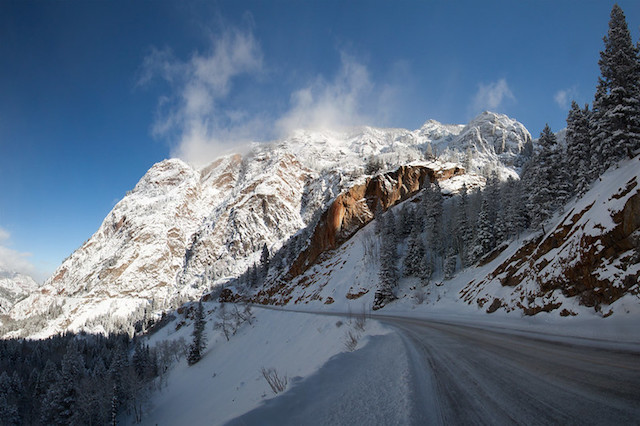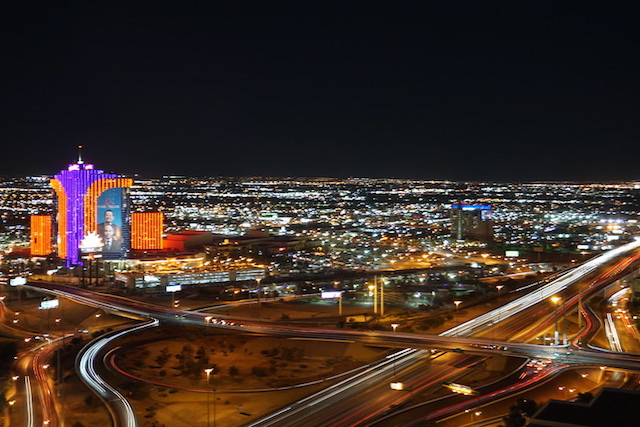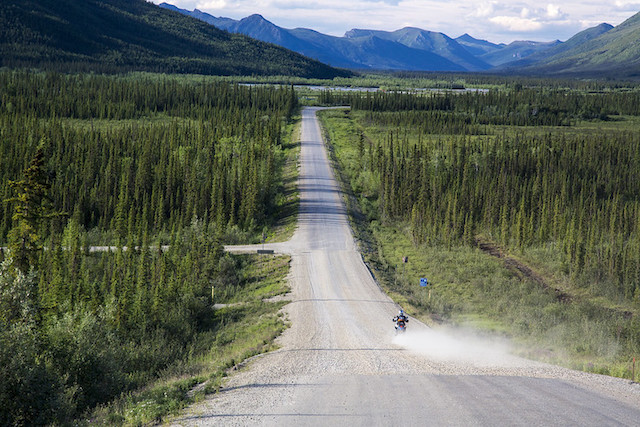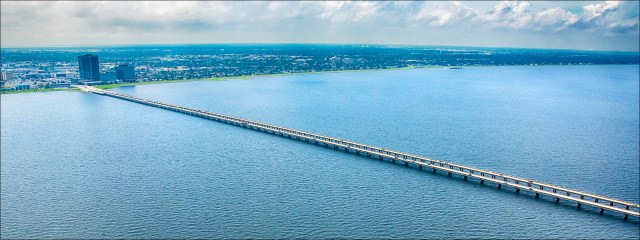It’s been said that danger lurks around every corner. This is never more true than on the road. Crashes can, and do, occur on any street, regardless of location, condition and speed limit. But not all roads are created equal. While some may have danger around the corner, others have danger all around. All this danger can make for some hair-raising drives.
Roads can be scary for a variety of reasons. Some travel through hazardous terrain, while others are so flat and straight they become breeding grounds for speeding and unsafe driving. You’ll find dangerous roads from coast to coast, in crowded metropolises and areas so remote they’re difficult to access.
Here’s a look at some of the scariest, nerve-racking roads in America.

Million Dollar Highway, Colorado
Officially known as U.S. Route 550, local legend says Colorado’s Million Dollar Highway got its moniker after an early traveler proclaimed she’d have to be paid $1 million to drive it again.
Winding through Red Mountain Pass in the San Juan Mountains, the roadway is undoubtedly one of the most breathtaking in the country. But those stunning views don’t come easily. You’ll encounter steep cliffs and hairpin turns as you climb the highway more than 11,000 feet above sea level. If that’s not unnerving enough, the road, carved into the side of the mountains, has no guardrails. Throw in some harsh Colorado weather and the occasional rock slide and you have one of the most dangerous roads in the country, according to a list compiled by USA Today.
U.S. Route 1, Florida
Florida doesn’t have Colorado’s mountains, but it does have another lurking danger: It’s one of roughly half the country’s states without a full ban on using a handheld cellphone while driving. That might help explain why a recent study found that 17 of the 100 deadliest roads in America were in the Sunshine State, the most in the country. The research, which looked at death totals from 2015 to 2019, found Florida’s section of U.S. 1 to be the country’s second deadliest road. In total, 87 people died there over that time.
Most of the route up the eastern coast is straight as an arrow, inviting drivers to reach dangerous speeds. The southern end, known as the Overseas Highway, connects the Florida Keys to Miami. It consists of miles and miles of bridge driving, something many people find distracting or unsettling.

Lake Pontchartrain Causeway, Louisiana
At nearly 24 miles long, the Lake Pontchartrain Causeway holds the Guinness World Record for longest bridge over water. Depending on how you feel about driving for a half-hour suspended over a lake, the causeway can be a thrilling or nerve-racking experience. When you get toward the middle of the bridge, where dry land is completely out of view, it will likely veer toward the latter.
Being surrounded by water also leaves drivers open to the elements: The causeway can become enveloped in fog so thick that police have to usher drivers across the lake.
I-4, Florida
Interstate 4 between Tampa and Daytona Beach was once found to be the deadliest interstate in the country, recording 1.41 fatalities per mile. One explanation for the road’s high incident rate could be its route directly through Orlando, one of the country’s premier tourist destinations. “What’s the first thing they do when they get off the plane?” Glenn Victor of the Florida Safety Council asked Fox 35 Orlando. “They rent a car that they’re not familiar with and they’re on their GPS, so they’re looking at the phone and their GPS which, of course, is a distraction while they’re driving.”
I-45, Texas
Some roads are innately dangerous because of how they were designed or the terrain they traverse. Others are dangerous simply because of how many drivers use them – and the number of ensuing crashes they cause. The congested Galveston to Dallas section of I-45, which runs through downtown Dallas, was recently named the deadliest road in America by Budget Direct. Citing heavy traffic and driver complacency, the company found I-45 averages 56.5 fatal accidents for every 100 miles of roadway.
I-10, Arizona
Interstate 10 spans the width of the country, stretching from Jacksonville, Fla., to Santa Monica, Calif., but it’s the roughly 300-mile stretch through Arizona that has proven most foreboding. The highway’s long, straight stretches through the desert are hot spots of high speeds, aggressive driving, illegal passing and inattentive drivers. Nearly 500 fatalities were recorded on Arizona’s I-10 over a recent six-year period.

I-15, Nevada and California
The 181-mile stretch of Interstate 15 connecting Las Vegas and Los Angeles is a straight, well-maintained roadway, conducive to safe traveling. And yet, it routinely ranks as one of the country’s most dangerous roads. One study looked at data over a 15-year span and found it to be the deadliest roadway in the country.
The problem isn’t the road – it’s the drivers. Motorists often speed on I-15 while traveling through the openness of the Mojave Desert. The fact they are likely coming or going from the party city of Las Vegas doesn’t help either. The same study found that nearly a quarter of the crashes occurring on that section of the I-15 involved a drunk driver.
I-285, Georgia
Atlanta’s I-285 is known as “The Perimeter” because it circles the city in a 64-mile loop. It connects all the area’s interstates and highways and, in doing so, welcomes an onslaught of traffic, including tractor-trailers. The combination of congestion, sharp turns, interchanges and large trucks has turned I-285 into a lethal stretch of pavement. In 2015, Vox calculated the road’s fatality rate at 3.5 per every 10 miles, which, at the time, made it the country’s deadliest interstate.
U.S. Route 17, South Carolina
Winding through forests, marshlands and oceanside towns, South Carolina’s Highway 17 is one of the most scenic drives in the southeast. But looks can be deceiving. The road is filled with an endless number of sharp, blind turns and narrow lanes. The area is also home as well as an abundance of wildlife, creating another potential driving hazard.
All told, U.S. 17 in South Carolina is one picturesque – but perilous – drive. In fact, one study named it the country’s most dangerous highway for summertime travel.

Dalton Highway, Alaska
The James Dalton Highway stretches 414 miles through the Alaskan wilderness from Fairbanks to Deadhorse, located on the shores of the Arctic Ocean. The dirt-and-gravel roadway was constructed in 1974 to help facilitate the oil industry and to this day is mostly used to transport oil.
The Dalton traverses through some of Alaska’s most treacherous terrain, including forests, tundras, steep grades and the Yukon River. Traveling along the road is so dramatic, in fact, it’s the focus of the hit television show “Ice Road Truckers.” But what makes the Dalton Highway particularly dangerous is its remoteness. There are only three towns along the entire route, which includes a 240-mile stretch without a single gas station or rest stop. Should something happen to you along the way, it may take a long time to get help.
Highway 2, Montana
Montana is the country’s fourth-largest state by size, but the eighth-smallest in population. This means you can drive for a quite some time before coming across anyone else. Open roads can lead to pleasant drives, but they can also be quite dangerous. Nowhere is this more true than on Montana’s Highway 2, which stretches east-west across the northern end of the state.
The roadway maintains a 70 mph speed limit, even as it winds through some mountainous regions. And while the scenic nature may be eye-popping, it also means you’re far away from the nearest help. In 2021, the median EMS call in Montana took a total of nearly 45 minutes. That number only gets higher when first responders have to travel to and from remote Highway 2.
Road to Hana, Hawaii
Driving around the islands of Hawaii seems like a journey through paradise, but be careful what you wish for, especially if you’re traveling along Maui’s Road to Hana.
The 52-mile road connects Kahului to Hana along the island’s rugged eastern shoreline. And though the highway offers picturesque views of mountaintops, lush greenery and crashing waves, the Road to Hana is far from a luxurious drive. Along the way, you’ll encounter a whopping 620 turns and 59 narrow bridges. The route requires such caution it takes motorists anywhere from two to four hours to complete. That’s why the Hawaii Tourism Authority recommends traveling with a permitted tour company instead.
Have you driven on any of these dangerous roads? Tell us in the comments below.
146 Thoughts on “Are These The Most Nerve-Racking Roads in America?”
Leave A Comment
Comments are subject to moderation and may or may not be published at the editor’s discretion. Only comments that are relevant to the article and add value to the Your AAA community will be considered. Comments may be edited for clarity and length.

















We are in Hawaii right now at a bed & breakfast off the Road to Hana. The B&B and it’s tropical environment and ocean views are beautiful and peaceful. However, my husband and I both agree that if you are weighing risk vs. reward, it’s not worth it to come here. The waterfalls on the road touted in the guidebooks often have “no parking” signs posted, so you’d have to violate the law to stop and see the waterfall. (There is one waterfall at a public park that does have parking on the road.) There are other beautiful places in Hawaii that have safer roads to get there. We are here in Maui shortly after the Lahaina fire which has reduced tourism down to almost nothing – even though we are 2-1/2 hours’ drive away from the disaster. The lack of traffic on the road has emboldened locals, who are driving too fast and not stopping across one-lane bridges at yield signs, even when our rental car is clearly already in the beginning of the bridge. To be fair to them, many one-lane bridges have yield signs that are a joke, because you can’t see the oncoming traffic with the severe curve in the road up ahead plus the heavy vegetation. I would never drive this road again. Driving the Road to Hana and not getting into a head-on collision on any one of its 61 one-lane bridges is sheer luck of the draw. We feel lucky to be unharmed. It’s not the relaxing vacation we envisioned. If you are going to drive the Road to Hana no matter what I say, drive it early on a Sunday morning when there will be little to no opposing traffic.